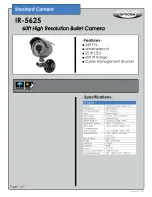
5
convenience to the operator should be the prime consideration when mounting the siren and controls
NOTE: Setups and adjustments will be made in subsequent steps, depending upon the model and options
purchased, that may require access to the rear area of the unit. Plan the installation and wiring accordingly.
Amplifier Connections
Siren Amplifier Connector - As a standard feature, the Siren and Auxiliary sections of your unit
come equipped with a combination plug-in terminal block/connector. To terminate the wires, strip
approximately 1/4" of insulation from the end of each wire and insert it in the appropriate hole in the
terminal block. Tighten the setscrew and proceed to the next connection.
Should you ever have to remove the unit, pull the terminal block straight out. It will unplug from the
unit, leaving the wiring in place.
Terminal Block Connections
Light Control Terminal Plug-
(see wiring diagram page 15)
COM - Connect to the wire from one 100 W ( 11 ohm ) speaker terminal 1.
SPKR - Speaker - Connect to the wire from 100 W ( 11 ohm ) speaker terminal 2.
NOTE: For all RLS sirens manufactured after April 2004, two 100W speakers may be connected in
parallel for 200 W operation. Correct phasing is important and can be accomplished by connecting
both speaker terminals marked " 1 " to the COM terminal and both speaker terminals marked " 2" to
the SPKR terminal. For sirens manufactured prior to April 2004, 200W operation was an optional
feature. Refer to the siren's wiring label to determine the power rating on these units.
REMOTE - Remote switch (Horn ring or foot switch). Circuit can be configured for both ground (earth)
or positive signals. A horn ring transfer circuit is standard in all 3990 series. Connect to the
"REMOTE" terminal on the Lighting Control Section terminal block. Unit is configured for a ground (
earth ) at the factory. See page 8 for details on configuring for a +12V input.
WARNING!
!
Larger wires and tight connections will provide longer service life for components. For high c u r r e n t
wires it is highly recommended that terminal blocks or soldered connections be used with shrink tubing to
protect the connections. Do not use insulation displacement connectors(e.g. 3M
®
) Scotchlock type
connectors). Route wiring using grommets and sealant when passing through compartment walls.
Minimize the number of splices to reduce voltage drop. High ambient temperatures (e.g. underhood) will
significantly reduce the current carrying capacity of wires, fuses, and circuit breakers. Use "SXL" type
wire in engine compartment. All wiring should conform to the minimum wire size and other
ecommendations of the manufacturer and be protected from moving parts and hot surfaces.
Looms, grommets, cable ties, and similar installation hardware should be used to anchor and protect all
wiring.
Fuses or circuit breakers should be located as close to the power takeoff points as possible and
properly sized to protect the wiring and devices. Particular attention should be paid to the location and
method of making electrical connections and splices to protect these points from corrosion and loss
of conductivity. Ground (Earth) terminations should only be made to substantial chassis
components, preferably directly to the vehicle battery.
The user should install a circuit breaker sized to approximately 125% of the maximum Amp
capacity in the supply line to protect against short circuits. For example, a 30 Amp circuit breaker
should carry a maximum of 24 Amps.
DO NOT USE 1/4" DIAMETER GLASS FUSES AS THEY ARE NOT SUITABLE FOR
CONTINUOUS DUTY IN SIZES ABOVE 15 AMPS. Circuit breakers are very sensitive to high
temperatures and will "false trip" when mounted in hot environments or operated close to their
capacity.





































